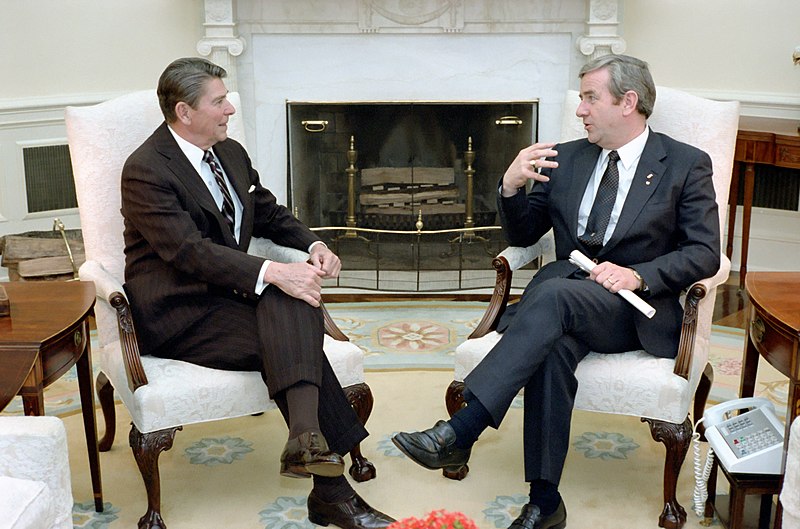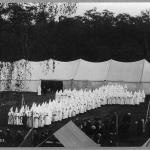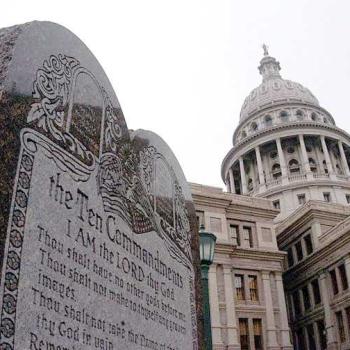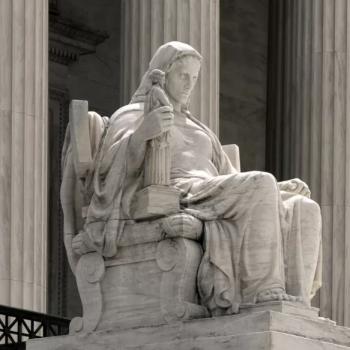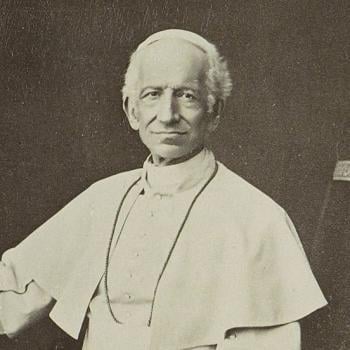This is a continuation of A Brief History of Christian Nationalism that will look at the pivotal role played by Jerry Falwell and the Moral Majority organization he founded. The last post traced how political operatives and interest groups over more than a century have gained support for their right-wing causes by linking them to Christianity. And now we’ve reached a point at which many people associate Christianity with right-wing politics. The Christian nationalist movement is the fruit of that association. Its members sincerely believe that only right-wing self-identified Christians — who may or may not know the Beatitudes from a toaster — are entitled to govern the United States.
To recap: The current Christian nationalism bears several similarities to the 1920s version of the Ku Klux Klan. Then, beginning in the 1930s a “Christian” movement, primarily bankrolled by the heads of Sun Oil, General Motors, the U.S. Chamber of Commerce, and the National Association of Manufacturers, persuaded many clergy and churchgoers that President Franklin Roosevelt’s New Deal was sinful and un-Christian. Christian ministers who didn’t realize they were being manipulated began preaching that the New Deal and all those government regulations and programs were rotting America from within. Jesus called on them to cast off state slavery and embrace unregulated free enterprise and rugged individualism. Christianity and capitalism belong together.
And in the 1950s and 1960s, the infamous John Birch Society promoted its anti-communist views in eschatological terms. Also working with churches, the JBS spread the idea that the Cold War wasn’t just a political struggle but was about good versus evil and God versus Godlessness. (I personally remember being taught this in Sunday school, ca. 1960.) The JBS also claimed that the Civil Rights movement, being led by the Rev. Dr. Martin Luther King, was working with communists to destroy America. This was a position taken seriously by FBI Director J. Edgar Hoover.
Now, let’s look at more recent history, which will take us to Jerry Falwell and the Moral Majority.
Desegregation and White Flight
In Brown v. Board of Education (1954) the Supreme Court ruled that all public school segregation was unconstitutional. This touched off decades of acrimonious struggle over racial desegregation of schools. This fight wasn’t just in the South. Whites rioted over school desegregation in Boston and Chicago, among other places around the country. But the South formed a unique response. By 1970 hundreds of new White segregation academies had sprouted up in 13 states, almost all in the South. According to “A History of Private Schools and Race in the American South” at the Southern Education Foundation, soon many southern state legislatures were passing laws that transferred public school money to these all-White, private schools.
The heads of most Christian denominations had praised the Brown decision, but at the parish level the story was often different. For example,
Protestant churches gave essential support to segregation academies in community after community. Typically churches helped new academies by volunteering use of their Sunday School rooms until an actual academy’s construction.
Briarcrest Baptist School in Memphis, which proclaimed itself the biggest non-Catholic Christian school system in the nation, initially spread out its classes between about a dozen Southern Baptist churches in the area. The school, organized for students to flee 1973 court-ordered busing in Memphis, was the setting for the book and film The Blind Side. The motto of its building campaign as busing began: “With God, nothing is impossible.”
See also How White Southern Christians Fought to Preserve Segregation by Kenneth Franz.
Jerry Falwell and the Moral Majority
You might remember the Rev. Jerry Falwell (1933-2007) for his crusades against legal abortion and LGBTQ rights. (He should not be confused with his son, Jerry Falwell, Jr.; his is another story.) But Falwell started out as a rabid segregationist. Falwell founded the Thomas Road Baptist Church in Lynchburg, Virginia, in 1956. That same year, he began a nationally syndicated radio and television program called The Old-Time Gospel Hour. The Thomas Road church became a megachurch, and Falwell became a powerful figure among southern segregationists. He preached fire and brimstone against Civil Rights, the Rev. Dr. Martin Luther King, and desegregation, although he also took a position that Christians should not get politically involved. In 1967 he opened a K-12 segregation academy, called the Lynchburg Christian Academy, affiliated with the Thomas Road church. Falwell co-founded Liberty University in 1971.
But in 1970, after a Supreme Court Decision, the IRS declared that racially segregated schools were not eligible for tax-exempt status. This impacted Bob Jones University in South Carolina. BJU was an unaffiliated evangelical university, founded in 1927, that in 1970 had never accepted Black applicants. BJU’s challenge of the IRS policy was fought through courts for years, until the Supreme Court ended the matter in 1983, ruling in favor of the IRS. While the Bob Jones case was making its way through appeals courts, many segregation academies reverted to a de facto segregation, declaring that they were not segregated by official policy but that, somehow, Black students just didn’t attend. These things happen. But in 1978, during the Jimmy Carter administration, the IRS proposed a new policy. The IRS wanted to see that the percentage of minority students in a student body was at least a fifth as large as the minority percentage in the community, or tax-exempt status might be revoked.
This policy proposal touched off a firestorm in the South. There was much screaming about government interference in Christian schools. (Of course, the schools were free to be as segregated as they wanted as long as they gave up tax-exempt status.) Jerry Falwell was very much wrapped up in the fight to keep segregation academies segregated and tax-exempt. However, he was visited by a Washington conservative operative named Paul Weyrich (1942-2008). Weyrich was a co-founder of the Heritage Foundation who had left the Roman Catholic Church because he felt it was too liberal after Vatican II. And he’s been called the architect of the Christian Right. With encouragement and much input from Weyrich, Falwell founded a new organization in 1979 — The Moral Majority.
A New Direction for the Christian Right
The Moral Majority was soon joined by many prominent evangelicals, such at televangelist Pat Robertson and Tim LeHaye, co-author of the Left Behind book series. It grew to seven million members and is credited with helping Ronald Reagan win the U.S. presidential election in 1980. In turn, the Moral Majority got a seat at the table of Republican policy issues. Falwell and other Moral Majority leaders also gained a huge public megaphone through the 1980s. It seemed that cable news producers especially couldn’t get through a day without putting a Moral Majority leader in front of a camera to promote the Majority’s point of view. Whenever any news story had a morality angle, news reporters rushed to get quotes from the Moral Majority.
And what were those views? They opposed feminism and the Equal Rights Amendment. They were adamantly opposed to LBGTQ rights. They spoke out against the teaching of evolution and wanted teacher-led school prayer to be returned to public school classrooms. And they were utterly opposed to the Roe v. Wade decision that affirmed a legal right to abortion. Falwell and crew were still critical of the Civil Rights movement, but suddenly school segregation was on the back burner. (Note that many evangelical leaders, including Falwell, had expressed little concern about the Roe v. Wade decision when it was decided.)
It’s been widely reported that Paul Weyrich persuaded Jerry Falwell and other evangelical leaders that the cause of racially segregated and tax-exempt private schools could not be achieved anytime soon. The only way they could go back to the white flight schools was to dominate Congress and the federal courts, and that would be a long-term goal. And the key to this would be embracing some specific wedge issues to drive conservative Christian Americans to the polls, in particular opposition to abortion and feminism and support for school prayer. They had to elect people at all levels of government who would support the Christian Right’s goals. Defending racism and racial segregation would turn off too many voters, however.
After the 1980s
The Moral Majority disbanded in 1989, mostly because of internal divisions. Among other things, Jerry Falwell had endorsed George H.W. Bush to win the Republican nomination for U.S. president in 1988, when Pat Robertson was running for the nomination himself. But though the organization was no more, the individuals that headed it were still nationally known figures who could command much coverage and attention in television news. Robertson had founded the Christian Coalition in 1988, and for the next few years the Coalition stepped into some of the void left by the Moral Majority.
In the 1990s, they honed some messages. For example, they no longer called for banning the teaching of evolution but insisted that intelligent design be taught as well. Through the Bill Clinton Administration they had less influence over national politics. Their biggest victory during the Clinton years arguably was the passage of the Defense of Marriage Act, in 1996, which required the federal U.S. government to recognize only heterosexual marriage — one man, one woman. The Supreme Court would rule the DOMA statute unconstitutional in 2013. and gay marriage was legalized nationwide in 2015.
The 2000 election of George W. Bush gave the Christian Right more influence again. President Bush called himself a “compassionate conservative” who played up his evangelical faith in his campaign. As President he went out of his way to set up church-government partnerships through his “faith-based initiatives” programs. The Religious Right praised Bush’s opposition to embryonic stem cell research and for voicing support for a constitutional amendment banning gay marriage after Massachusetts legalized it in 2003. But after Barack Obama became president in 2009, the Christian Right’s influence was diminished again.
Today
The Christian nationalist movement we’re seeing today, I think, is the result of a century of the politization of Christianity in support of conservative issues and Republican politicians. The return of a Republican, Donald Trump, to the White House in 2017 seemed to release much pent-up frustration among people who believe they are divinely entitled to power. “The religious right has long supported conservative causes, but this current wave seeks more: a nation that actively prioritizes their particular set of Christian beliefs and far-right views and that more openly embraces Christianity as a bedrock identity,” Elizabeth Dias wrote in the New York Times.
Christianity as an identify is critical. Writing in Time, historian Andrew Whitehead called Christian nationalism, “a political theology that fuses American identity with an ultra-conservative strain of Christianity. But this Christianity is something more than the orthodox Christianity of ancient creeds; it is more of an ethnic Christian-ism.” I think that’s exactly right. What strikes me about this new generation of militant Christian activists is how unreligious many of them seem. It would be fun to give them a pop quiz on Jesus’ parables. How many would pass? They may not be devout, prayerful, or meek, but they are Republicans on Team Jesus, so theirs is the Kingdom of Heaven.
This two-part series is an extremely concise account of a century of the mingling of church and politics, and of course I’ve left a lot out. (For more of the story, see The Long History of the Religious Right.) But I hope to flesh out more details in future posts.
